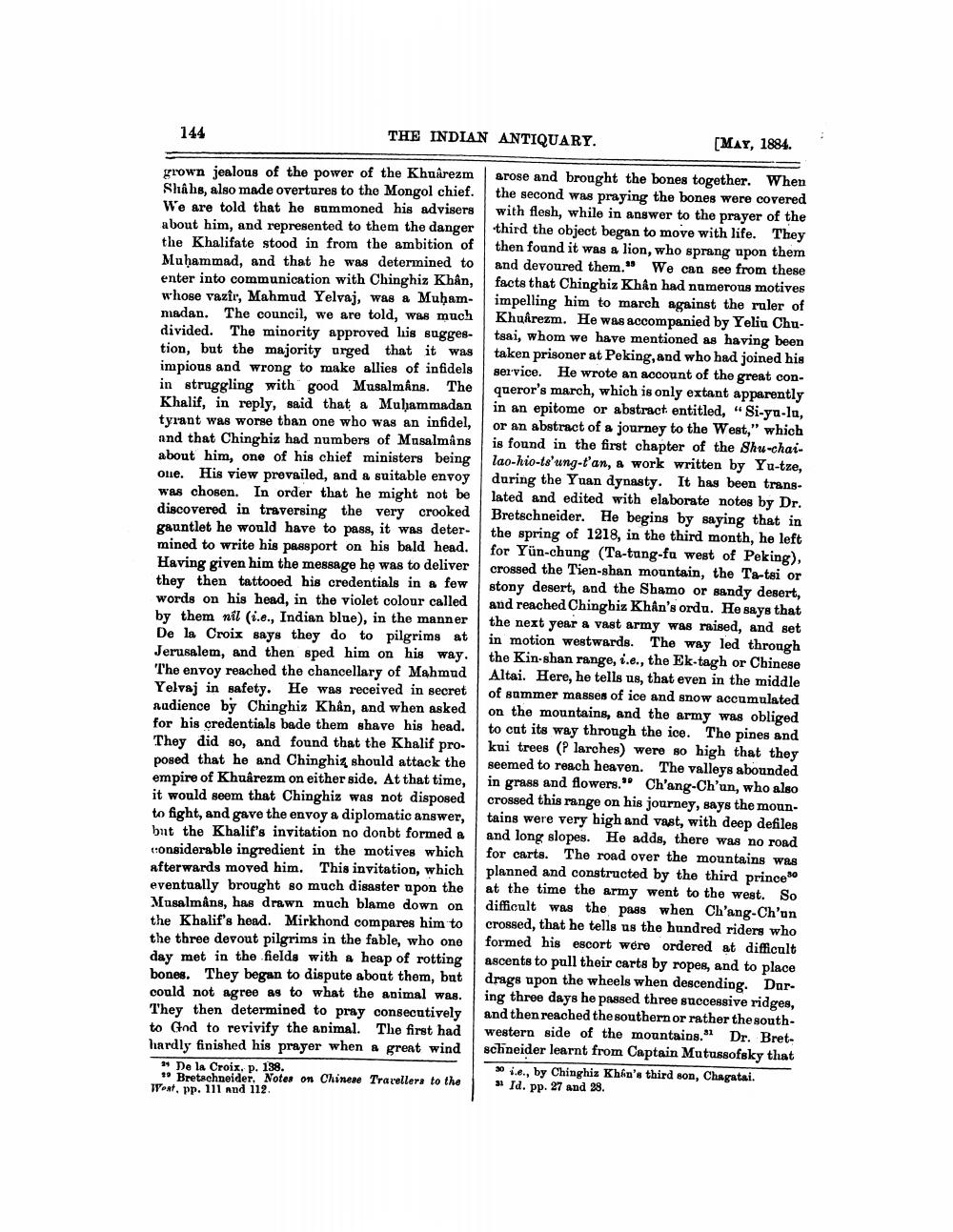________________
144
THE INDIAN ANTIQUARY.
grown jealous of the power of the Khuârezm Shahs, also made overtures to the Mongol chief. We are told that he summoned his advisers about him, and represented to them the danger the Khalifate stood in from the ambition of Muḥammad, and that he was determined to enter into communication with Chinghiz Khân, whose vazir, Mahmud Yelvaj, was a Muḥammadan. The council, we are told, was much divided. The minority approved his suggestion, but the majority urged that it was impious and wrong to make allies of infidels in struggling with good Musalmâns. The Khalif, in reply, said that a Muhammadan tyrant was worse than one who was an infidel, and that Chinghiz had numbers of Musalmâns about him, one of his chief ministers being one. His view prevailed, and a suitable envoy was chosen. In order that he might not be discovered in traversing the very crooked gauntlet he would have to pass, it was determined to write his passport on his bald head. Having given him the message he was to deliver they then tattooed his credentials in a few words on his head, in the violet colour called by them nil (i.e., Indian blue), in the manner De la Croix says they do to pilgrims at Jerusalem, and then sped him on his way. The envoy reached the chancellary of Mahmud Yelvaj in safety. He was received in secret audience by Chinghiz Khân, and when asked for his credentials bade them shave his head. They did so, and found that the Khalif proposed that he and Chinghiz should attack the empire of Khuârezm on either side. At that time, it would seem that Chinghiz was not disposed to fight, and gave the envoy a diplomatic answer, but the Khalif's invitation no donbt formed a considerable ingredient in the motives which afterwards moved him. This invitation, which eventually brought so much disaster upon the Musalmâns, has drawn much blame down on the Khalif's head. Mirkhond compares him to the three devout pilgrims in the fable, who one day met in the fields with a heap of rotting bones. They began to dispute about them, but could not agree as to what the animal was. They then determined to pray consecutively to God to revivify the animal. The first had hardly finished his prayer when a great wind
2De la Croix. p. 138.
29 Bretschneider. Notes on Chinese Travellers to the West, pp. 111 and 112.
[MAY, 1884.
arose and brought the bones together. When the second was praying the bones were covered with flesh, while in answer to the prayer of the third the object began to move with life. They then found it was a lion, who sprang upon them and devoured them." We can see from these facts that Chinghiz Khân had numerous motives impelling him to march against the ruler of Khuârezm. He was accompanied by Yeliu Chutsai, whom we have mentioned as having been taken prisoner at Peking, and who had joined his service. He wrote an account of the great conqueror's march, which is only extant apparently in an epitome or abstract entitled, "Si-ya-la, or an abstract of a journey to the West," which is found in the first chapter of the Shu-chailao-hio-ts'ung-t'an, a work written by Yu-tze, during the Yuan dynasty. It has been translated and edited with elaborate notes by Dr. Bretschneider. He begins by saying that in the spring of 1218, in the third month, he left for Yün-chung (Ta-tung-fu west of Peking), crossed the Tien-shan mountain, the Ta-tsi or stony desert, and the Shamo or sandy desert, and reached Chinghiz Khân's ordu. He says that the next year a vast army was raised, and set in motion westwards. The way led through the Kin-shan range, i.e., the Ek-tagh or Chinese Altai. Here, he tells us, that even in the middle of summer masses of ice and snow accumulated on the mountains, and the army was obliged to cut its way through the ice. The pines and kui trees (? larches) were so high that they seemed to reach heaven. The valleys abounded in grass and flowers." Ch'ang-Ch'un, who also crossed this range on his journey, says the mountains were very high and vast, with deep defiles and long slopes. He adds, there was no road for carts. The road over the mountains was planned and constructed by the third prince" at the time the army went to the west. So difficult was the pass when Ch'ang-Ch'un crossed, that he tells us the hundred riders who formed his escort were ordered at difficult ascents to pull their carts by ropes, and to place drags upon the wheels when descending. Daring three days he passed three successive ridges, and then reached the southern or rather the southwestern side of the mountains. Dr. Bretschneider learnt from Captain Mutussofsky that
30.e., by Chinghiz Khan's third son, Chagatai. 31 Id. pp. 27 and 28.




